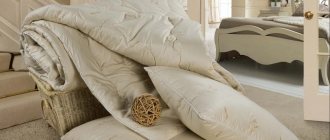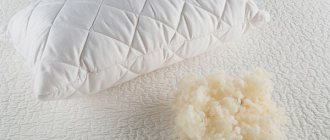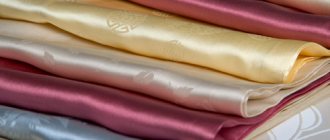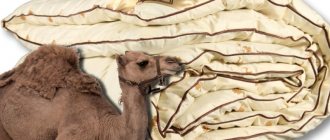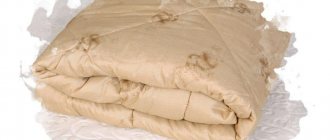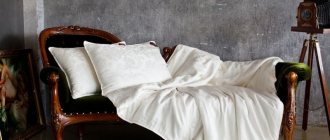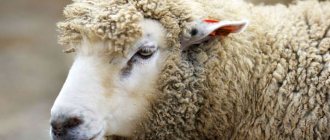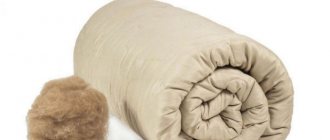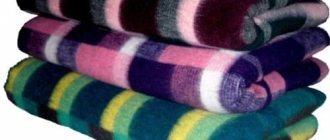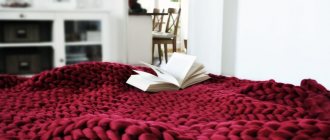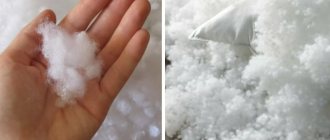- Hygroscopicity . Absorbs moisture and evaporates, the item is always dry and warm.
- Air permeability . A comfortable microclimate is created. Air passes easily through the material.
- A natural antiseptic is lanolin , it destroys toxic substances released by sweat.
- Health-improving effect . Blood circulation improves, pain in osteochondrosis, radiculitis, arthrosis and arthritis decreases.
- Antistatic . When used, the material is not electrified.
- Sustainability . Retains its shape, the fleece is elastic and elastic.
- Affordable price.
- Allergenicity . Not suitable for people suffering from animal protein intolerance. Dust mites can live in wool.
- Peculiar smell of sheepskin.
- Tracks quickly . Low service life.
- Difficult care . The product cannot be washed, it must be dry cleaned.
- Heaviness . Sheep wool blankets are on average twice as heavy as down or camel blankets.
Decorative model Oviland “Flowers” 200×220. Can be used without a duvet cover.
How sheep's wool is obtained and prepared for making blankets
Sheep wool is now obtained in the same way as hundreds of years ago - by shearing sheep. Animals do not suffer and quickly grow new hair.
It is believed that the best sheep's wool is sheared in May.
Processing of the obtained material consists of six stages:
- sorting. At this stage, the collected raw materials are separated from the garbage and sorted by length and quality;
- cleaning. During this stage, workers remove various small dirt and impurities from the wool: pieces of dried skin, adhered dirt, manure, grass;
- flushing This stage is carried out using detergents similar in properties to wool washing powders. This treatment is required to remove fat and sweat from sheep. Washing makes the material softer to the touch;
- drying. Sheep wool is usually dried naturally. To do this, it is laid out on the bedding in a thin layer and left in the fresh air. Good drying also ventilates the material and removes excess odors from it;
- combing. The matted fur must be combed out so that it can be used in the future;
- whipping. The material is laid out on a flat surface and beaten. In the household, a long metal rod is used for this - they beat the wool with it so that it becomes more voluminous and elastic. The fluffed wool can be placed in a blanket cover.
The processed material is either placed in a prepared textile cover, or an open blanket is made. The finished product is often quilted so that the wool lies evenly for a long time.
In addition to blankets, mattresses and pillows are made from sheep wool (the manufacturing technology is practically the same), carpets, towels, and yarn is also spun. It can then be used to create beautiful and warm knitted products that have the same beneficial properties as wool itself.
Video: how sheep mattresses are made
Peculiarities
The wool blanket is unique, and combines warmth, lack of moisture while sleeping under it, lightness and durability. Today's models are very different from those produced in the past, which were prickly, stiff and heavy.
Things are produced woven or printed, in which wool will be a filler. The latter are fluffy, thick, and soft, as they have covers made from natural fabrics (cotton, bamboo). Even people with hypersensitive skin use them. The stuffed model is used as a mattress cover. This option is especially good for children and people who, due to health reasons, are forced to spend a long time lying in bed.
Merino wool blanket is the most expensive. This material has increased softness and warmth. In fact, it is no longer hair, but fluff. Models made from wool of this quality are usually woven.
Types of sheep wool blankets
Sheep wool blankets vary in shape, manufacturing method and density. The last parameter divides all products into:
- light (density 100–200 g/m2);
- lightweight or universal (200–300 g/m2);
- standard (300–400 g/m2).
It is extremely rare to find heavier blankets with a density of up to 800 g/m2. They are not in demand and appear in stores rarely. The higher the density of the blanket, the warmer it is, but at the same time the heavier it is. Choose this option depending on your home environment.
Open wool (woven)
Soft and pleasant to the touch, open wool blankets are well suited for the summer. They are less warm than closed products, but provide more benefits due to direct skin contact with the sheepskin. These blankets can be double-sided or single-sided. The first ones are the most expensive products. They are made from woven sheep's wool on both sides. Single-sided ones have such a coating on only one side. The other side (base) is made of textile material, usually satin or polycotton.
The open blanket made of sheep wool is very pleasant to the touch
With closed hair
The most common type of sheep blanket is the closed type. They are warm enough and suitable for cold winter nights. When making this type of blanket, the fluffed wool is placed in a textile cover. It is made from cotton, satin, calico or polycotton. Closed quilts are now almost always quilted. This means that after filling the cover with wool, the product is stitched through to achieve an even and reliable distribution of the filler. Quilts are divided according to the type of stitching into quilted and cassette.
Karostepnye
Karostep blankets are made by stitching the cover and wool in the form of a pattern. The advantage of such a product is its high decorative effect. The main disadvantage is less efficient distribution of the filler. Therefore, when choosing, you should pay attention to the shape of the pattern. A pattern that is too large may not effectively keep the wool from matting.
It is worth noting that karostep blankets are usually purchased for use without a duvet cover due to their attractive appearance. However, it is worth remembering that after a couple of years of use, the holes from the needles may increase in size, due to which the filler will be visible from the outside. This will worsen the appearance of the product.
The karostep blanket looks attractive, but with prolonged use it may lose its original appearance.
Cassette
The cassette blanket can be called the best among closed ones. It is stitched in the form of identical sections - cassettes. This stitch allows you to most effectively maintain an even distribution of wool inside the cover. The cassette blanket withstands washing better than others and lasts longer. The main disadvantage is the relatively high price compared to other types of closed blankets.
A cassette blanket is easily recognized by its repeating square or diamond-shaped sections
Which duvet filler is best to buy?
Each type of “filling” for bedding has its own characteristics, strengths and weaknesses. Synthetic analogues will cost less than natural ones, but the latter are hypoallergenic and environmentally friendly. Which filling for a blanket is better, I will suggest the following results of the top rating:
- The warmest filling for harsh winters is cashmere;
- Filling for people with problematic spine and joints – sheep wool;
- The cheapest filler is padding polyester;
- Maximum service life – linen;
- The best antibacterial properties are bamboo.
The warmest bedding contains down and wool. An excellent alternative to them would be “filling” made from plant fibers, but they are more suitable for cool or warm seasons. Synthetic versions of the latest generation have high consumer properties. Before choosing which blankets are best to buy, with which filling, it is important to familiarize yourself with the characteristics, care requirements, and reviews.
Healing properties, pros and cons of sheep wool blankets
Sheep wool as a material has beneficial qualities for humans. Among them:
- dry heat. Due to the composition of wool, dry and warm air is retained under a sheep blanket. This reduces the risk of developing or exacerbating arthritis, muscle and joint pain, and also speeds up recovery from colds;
The blanket is quite warm, because its base is sheep wool.
Well stitched and quilted. The only negative that I discovered for myself is washing. His resolution is dry clean only. pieceofice https://otzovik.com/review_956430.html - hard fibers. A sheepskin blanket can act as a kind of massager, improving blood flow and promoting relaxation;
- low thermal conductivity. Sheep wool does not allow heat or cold to pass through. Therefore, under such a blanket the most comfortable temperature is maintained. It doesn’t matter whether it’s cold or hot outside;
- antistatic. Household appliances found in every home generate a lot of static electricity. Due to its excess, people can suffer from headaches, insomnia, and nervous disorders. Sheep wool is a natural antistatic agent;
- high moisture evaporation. Sheep wool does not retain absorbed moisture. Therefore, even people who are prone to excessive sweating are comfortable under such a blanket;
- breathability. Another property that allows a sheepskin blanket to create a comfortable microclimate. Due to the shape of the hairs, air circulates freely through the material. This prevents the formation of a “greenhouse” under the blanket;
- low cost. One of the important advantages of sheep wool is its very low production cost compared to other materials.
Sheep wool is naturally coated with a thin layer of special wax - lanolin. It has a low melting point and melts upon contact with the human body. This wax helps soften the skin. However, there is currently no reliable information that sufficient lanolin remains on the wool used to make blankets for the effect to be even slightly noticeable.
Sheep wool also has a number of disadvantages:
- allergenicity. A sheep's wool blanket is not suitable for people with allergies to animal protein. Don’t forget about household mites, which are a common allergen. However, these microscopic pests are found not only in sheep blankets, but also in any others that can accumulate dust;
Dust mites are a common allergen, and they feel quite comfortable in a sheepskin blanket. - short shelf life. Sheep blankets cake quite quickly. As a rule, their period of use does not exceed 10 years;
- heaviness. Sheep wool blankets are approximately twice as heavy as camel or down blankets;
- Quite difficult to care for. A sheepskin blanket cannot simply be machine washed. The best option is dry cleaning. At worst, hand wash using wool products.
Table: comparison of sheep and camel blanket
| Parameter | sheep blanket | Camel wool blanket |
| Weight | Heavier | Lighter |
| Appearance | Big choice | Poor color range, because... camel hair does not lend itself well to coloring |
| Price | Average | Usually 1/3 higher than the cost of a sheepskin blanket |
| Tactile sensations | Soft, pleasant | Can be prickly |
| Durability | Service life is about 10 years | On average, camel wool lasts one and a half to two times longer than sheep wool. |
| Care | Dry cleaning only or hand wash using special products | You can even wash it in a machine |
| Allergenicity | Not suitable for people with allergies to animal protein | May cause an allergic reaction |
How to choose a sheep wool blanket
The selection of a blanket depends on the purpose of its use. First, decide on the density of the product. For summer, blankets with a density of up to 200 g/m2, as well as open blankets, are quite suitable. If the house is cold, choose closed products with a density of at least 300 g/m2.
A sheep wool blanket can be purchased for a child if he does not have asthma or allergies. Otherwise, abandon animal material in favor of silk or at least cotton wool. Adults with these diseases can purchase a sheepskin blanket only in case of stable remission.
When choosing the size of the blanket, start from the standard dimensions. Otherwise, it will be quite difficult to find a bedding set that matches the purchased product. It’s easy to determine the appropriate size:
- A one-and-a-half-sleeping room is suitable for one adult. Its size is 140 x 205 cm;
- A double bed is suitable for a couple who is comfortable sleeping under one blanket. Dimensions - 220 x 220 cm, 175 x 205 cm, 220 x 240 cm ("king size", for large beds);
- euro - a little more than a one-and-a-half-sleeper. Suitable for one person, but it is better not to buy this blanket for a narrow bed because it will hang almost to the floor. Dimensions - 155 x 205 cm;
- The baby blanket is suitable for children up to 120 cm tall. Dimensions: 110 x 140 cm.
When choosing a blanket, consider the purpose of its use, the future owner and size
. To purchase the highest quality product, pay attention to the following points:
- weight. A weightless, very light blanket is most likely not made from 100% sheep wool, but using synthetic fillers, even if the label says otherwise. It’s better not to take a blanket that seems unnaturally light to you. It does not have all the beneficial properties of sheep wool;
- smell. High-quality processed sheep wool does not have a synthetic odor. If a product in a store seems to smell like some kind of household chemical, it is better not to purchase it. Getting rid of such a smell can be extremely difficult. Another issue is the natural smell of wool. It is easy to distinguish from a chemical aroma. It wears off within a month;
Six months ago I bought a sheep wool blanket. Yes, at first there was a smell, but this only indicates that the product is natural. The smell disappeared after 2-3 weeks. It's very warm. And in the summer it’s not hot under it.
Olya https://www.woman.ru/home/Interior/thread/3920892/2/
- Do the villi come out? From a quality blanket (whether open or closed), wool should not come out without serious effort. If you run your hand over a product and individual hairs fall off, then its durability is highly questionable. This is especially important when purchasing open blankets. Try to pinch off a little hair from it - you should not succeed.
Features of caring for a sheep blanket
Caring for products made from sheep wool is quite complicated:
- it should not be exposed to temperatures above 40 degrees - it will turn out to be felt;
- it does not tolerate strong mechanical stress, because of this the wool quickly becomes matted and it will no longer be possible to straighten it back.
Therefore, machine washing of sheep blankets is contraindicated. The best option for cleaning a sheepskin blanket is dry cleaning. Such companies have sufficient experience and the necessary equipment that is suitable for dry safe cleaning of the product. The cost of such a service depends on the city and usually varies from 1,000 to 3,000 rubles.
You can wash the blanket yourself or take it to the dry cleaner
If you do not have the opportunity or desire to contact professionals, perform gentle cleaning at home:
- Dissolve wool detergent in a bowl of cool water. Whip up a stiff foam.
- Apply the foam to the blanket using a sponge. The brush can only be used on closed blankets; there is no need to run it through the wool.
- Using a damp sponge, remove all foam from the product.
If the blanket is very dirty, you will have to resort to hand washing:
- Fill the bathtub with water at a temperature no higher than 30 degrees and dilute wool detergent in it.
- Submerge the blanket in the bath. It cannot be rubbed, squeezed or twisted. You can only carefully lift it and lower it deeper.
- Drain the water without removing the blanket from the bathtub. Rinse it with a low-pressure shower until the water runs clear.
- Without wringing, straighten the blanket in the bathroom. Leave it until water stops dripping.
- When the blanket dries a little, transfer it to a flat horizontal surface and carefully straighten it. Leave for a day until completely dry.
Video: how to wash a sheep's wool blanket
Rating of blanket fillings
Among home textile products, it is difficult to immediately make a choice in favor of something specific. In addition to the reliability of manufacturers, one should rely on quality, performance characteristics, reliability and service life. Leading experts identify several determining criteria for choosing a blanket based on filling:
- Warmth degree - on a scale from 1 to 5 for different seasons;
- Comparability of the filler with the cover - volume to fabric density;
- Blanket size – child, single, double or euro;
- Hypoallergenic - natural;
- Air permeability - how much a material can “breathe”;
- Other characteristics - moisture exchange, shape retention, etc.;
- Features of care - cleaning, processing, drying.
Since for most buyers the determining factor is the budget, the degree of high cost and the price-quality ratio were taken into account. Feedback from users who were convinced from personal experience of the strengths and weaknesses of different sleeping materials was useful.
The best stain removers
Manufacturers and prices
When purchasing a blanket, pay attention to the manufacturer. The textile factory must have a good reputation. Check out the list of the most recognized companies:
- "Spartacus". The Russian textile factory makes products from natural materials, so when purchasing, you don’t have to worry about the quality of the wool. Sheep blankets from this factory cost from 600 rubles;
- Magic Wool. This company specializes specifically in wool products, therefore it uses proven and high-quality fleece as raw material. Blankets of this brand will cost 800 - 2000 rubles;
- Vega. The company initially produced mattresses, but gradually expanded its range and now produces all bedding products, including sheepskin blankets. The cost of products starts from 400 rubles;
- "Ivteksprom". The textile factory from Ivanovo has a large assortment of both cheap and expensive blankets. The company carefully checks raw materials for quality. The cost of blankets starts from 400 rubles.
Nuances of choosing varieties
Thanks to the use of natural wool as a filler, the product becomes weightless and voluminous, and therefore comfortable and warm. Dry heat is considered useful and therapeutic in terms of warming joints, muscles and other parts of the body.
Choosing a wool blanket is actually not as simple as many people think. The main thing is to know the necessary characteristics and prevailing qualities of fabrics. You can see the options for blankets made from different types of wool in more detail in the photo.
